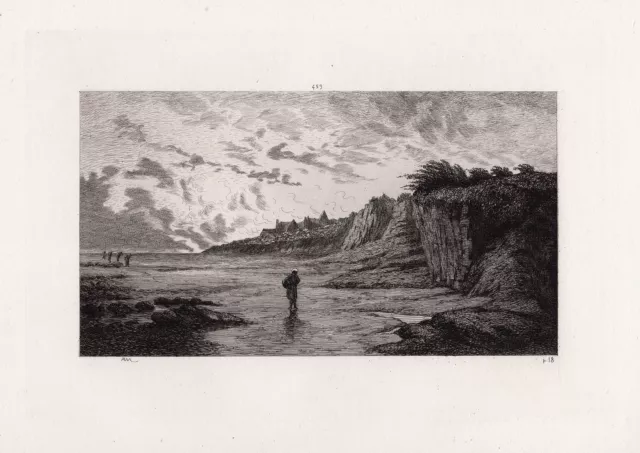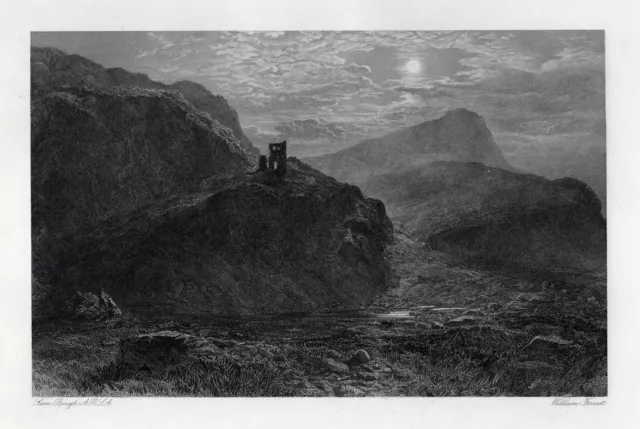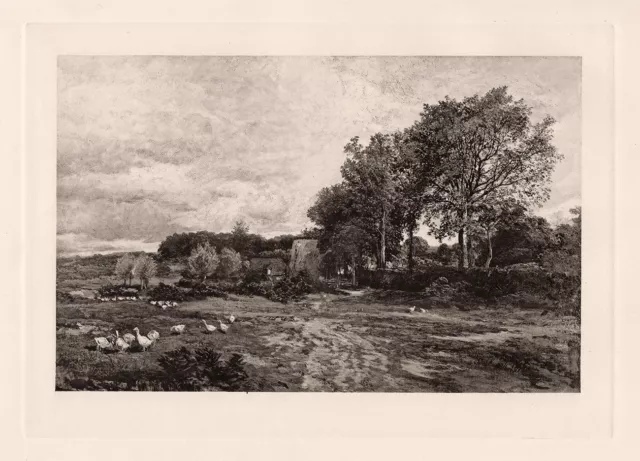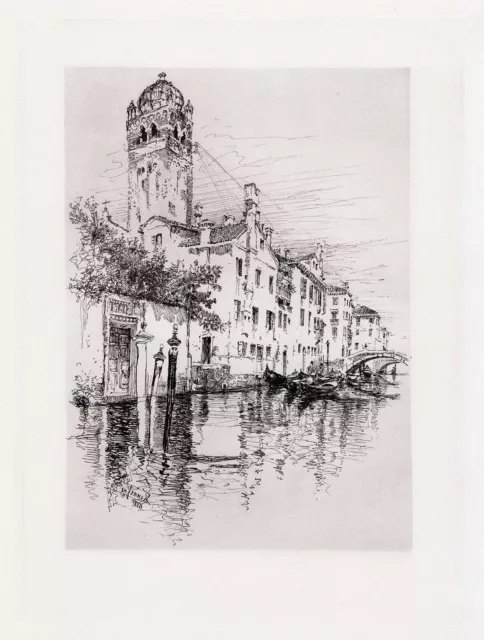Great 1800s Samuel Bough Etching "Historic Cellardyke Harbour" Framed Signed COA
Four Centuries of the world's finest artists from our collection to yours
Thank you for visiting...
Artist: Samuel Bough (English,1822-1878)
Title: Cellardyke Harbour, Firth of Forth Medium: Antique copper plate etching on thick laid paper after the original by master etcher Theophile-Narcisse Chauvel (1831-1909). Signature: Signed in the plate. Year: 1879 Condition: Excellent
Dimensions: Image Size 8 1/2 x 10 1/2 inches. Framed dimensions: Approximately 18 x 20 inches. Framing: This piece has been professionally matted and framed using all new materials.
Additional notes: This is not a modern print. This impression is more than 135 years old. The strike is crisp and the lines are sharp. Extra Information: Cellardyke is a village in the East Neuk of Fife, Scotland. The village is to the immediate east of Anstruther and is to the south of Kilrenny. Cellardyke was formerly known as Nether Kilrenny or Sillerdyke, and the harbour as Skinfast Haven, a name which can still be found on maps today. The harbour was built in the 16th century and was rebuilt in 1829-31. The modern name of the town is thought to have evolved from Sillerdykes (Eng: silverwalls), a reference to the sun glinting off fish scales encrusted on fishing nets left to dry in the sun on the dykes around the harbour. Cellardyke and Kilrenny were together a royal burgh from 1592, having been a burgh of regality since 1578. Cellardyke is officially part of Kilrenny parish, and also part of the Anstruther fishing district, its fortunes fluctuating with the fishing trade. The population grew quickly in the 19th century and by the 1860s Cellardyke was a thriving town, with more than fifty boat owners and skippers year round, and one hundred other captains joining in for the annual herring fishing drive or Lammas drave which took place around the Lammas festival on 1 August. There was also a February surge in fishing, when shoals of herring arrived in the Firth of Forth. The fish curers of Cellardyke salted and smoked cod and herring from Anstruther as well as their own fish, sending some to London, and some as far as the West Indies. Fishing was a hazardous occupation, and over the years a number of boats from Cellardyke were lost. On 6 April 1826 a boat was lost. Seven of the crew perished and one survived. On 28 May 1844 a boat with eight crew members was lost. Two years later, on 23 April 1846 a boat with seven crew was lost. On 3 November 1848 a boat with eight crew was lost. The next loss occurred on 10 May 1865, when a boat with eight crew disappeared. In 1910 a boat from Pittenweem sank off Cellardyke with the loss of three lives. There was one survivor. In addition, on 1 July 1837 a boat from Cellardyke carrying people on an excursion to the Isle of May as part of a celebration for the start of the herring fishing foundered. Seventeen women and children lost their lives. Like many harbours in Scotland, the fishing fleet that once occupied the harbour has been largely replaced by pleasure craft. Around 200 fishing boats were once based here but much of the fleet was destroyed by a storm in 1898, with most of those left intact relocating a short way down the coast to Anstruther. Cellardyke harbour is now home to a few small creel and pleasure boats. The Firth of Forth is the estuary (firth) of several Scottish rivers including the River Forth. It meets the North Sea with Fife on the north coast and Lothian on the south. It was known as Bodotria in Roman times. In the Norse sagas it was known as the Myrkvifiörd. Artist Biography: Samuel Bough was an English-born landscape painter who spent much of his career working in Scotland. He was born the third of five children in Abbey Street, Carlisle in northern England, the son of James Bough (1794-1845), a shoemaker, and Lucy Walker, a cook. He was raised in relative poverty, but with a keen encouragement in the arts. He was self-taught but mixed with local artists such as Richard Harrington and George Sheffield, and was strongly influenced by the work of Turner. After an unsuccessful attempt to live as an artist in Carlisle he obtained a job and as a theatre scenery painter in Manchester in 1845, later also working in Glasgow in the same role. Encouraged by Daniel Macnee to take up landscape painting he moved to Hamilton from 1851-4 and worked there with Alexander Fraser. In Cadzow Forest (1857, Bourne Fine Art), influenced by Horatio McCulloch, is a 'magnificent' portrait of two ancient trees. In 1854 he moved to Port Glasgow to work on his technique of painting ships and harbours. He also began supplementing his income by illustrating books, before moving to Edinburgh in 1855. Off St Andrews by Sam Bough(1856, oil on canvas), National Galleries of Scotland On coming to Edinburgh he lived in a terraced house at 5 Malta Terrace in the Stockbridge area of the city. Following Turner's example, he became a skillful painter of seaports. Examples include St. Andrews (Noble Grossart) and The Dreadnought from Greenwich Stairs: Sun Sinking into Vapour (1861, private collection). He later fell out with McCulloch (their dogs apparently taking sides in the dispute). He was admired by Robert Louis Stevenson and painted a view of his house at Swanston, and the construction of Dubh Artach lighthouse. The engineering work for the latter was undertaken by the brothers Thomas and David Stevenson, Robert Louis' father and uncle respectively. His health began to fail in 1877 and in January 1878 he suffered a stroke. He died of prostate cancer at his later home, Jordan Bank Villa in Morningside, on the south side of the city. R. L. Stevenson penned a glowing obituary of Bough. He was buried in Dean Cemetery Edinburgh on 23 November 1878. The grave bears a bronze medallion of his head and faces over a southern path to the south terrace.
Accompanied by a Certificate of Authenticity and is Fully Guaranteed to be Certified as Described
| Framing |
| Any framing included in a listing is double matted and framed in a solid wood moulding. We can also frame any pieces not listed as such. Please contact us for pricing. We are usually half the price of a regular framer. |
| Shipping |
| Packages are shipped the next business day after confirmed payment is received. If you are making multiple purchases, please request an invoice so that we may combine shipping charges for you. |
| Guarantee |
| We guarantee all our listings to be 100% as described |
| Returns |
| Returns are accepted up to fourteen days after receiving your purchase. Buyer accepts responsibility for any additional shipping charges. |
| Click here for HOT DEALS | Click here for our NO RESERVE AUCTIONS |
&- Artist: Samuel Bough
- Production Technique: Etching
- Framing: Framed
- Style: Old Master
- Material: Etching
- Type: Print
- Features: Framed, Matted, Signed
- Subject: Famous Places
- Signed: Signed
- Year of Production: 1879
- Size Type/Largest Dimension: Medium (Up to 30in.)
- Listed By: Dealer or Reseller
- Print Type: Etching
- Date of Creation: 1800-1899
PicClick Insights - Great 1800s Samuel Bough Etching "Historic Cellardyke Harbour" Framed Signed COA PicClick Exclusive
- Popularity - 0 watchers, 0.0 new watchers per day, 587 days for sale on eBay. 0 sold, 1 available.
- Best Price -
- Seller - 2,790+ items sold. 0% negative feedback. Great seller with very good positive feedback and over 50 ratings.
People Also Loved PicClick Exclusive

Great Antoine CHINTREUIL SIGNED 1800s Etching "Morning Walk Low Tide" Framed COA
£191.96 Buy It Now 14d 11h
Samuel BOUGH SIGNED 1800s Engraving Edinburgh's Forgotten Stone Cairn FRAMED COA
£220.07 Buy It Now 6h 57m
Great 1800s Alfred Dawson ORIGINAL Etching "Historic Old Hull" Signed FRAMED COA
£216.06 Buy It Now 15d 10h
Samuel BOUGH 1800s Antique Print "Holmwood Common Landscape" Framed SIGNED COA
£179.91 Buy It Now 7d 19h
Beautiful 1800s Joseph PENNELL Etching "A Venetian Palazzo" SIGNED Framed COA
£240.15 Buy It Now 20d 8h
WOW 1800s Samuel BOUGH Engraving "Appraoch of the Great Storm" Signed FRAMED COA
£236.14 Buy It Now or Best Offer

